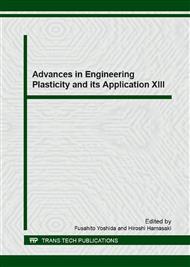[1]
T. Abe, Surface roughening and formability in sheet metal forming of polycrystalline metal based on r-value of grains, Int. J. Mech. Sci. 86 (2014) 2-6.
DOI: 10.1016/j.ijmecsci.2013.12.017
Google Scholar
[2]
T. Abe, Key Eng. Mat. 626 (2015) 566-569 (AEPA2014).
Google Scholar
[3]
R. Hill, The Mathematical Theory of Plasticity, Oxford Univ. Press, (1950).
Google Scholar
[4]
J. A. Elias, R. H. Heyer, J. H. Smith, Plastic anisotropy of cold rolled-annealed low-carbon steel related crystallographic orientation, Trans. Metallurgical Soc. AIME, 224 (1962) 678-686.
Google Scholar
[5]
S. Nagashima, Texture and anisotropy in metallic materials, J. Soc. Mat. Sci., Japan 32 (1983) 705-715.
Google Scholar
[6]
D. N. Lee, Texture and Related Phenomena, 2nd ed., Korean Institute of Metals and Materials, Seoul, (2014).
Google Scholar
[7]
T. Abe, Deformation of polycrystalline metal composed of anisotropic crystals having linear stress-strain relation, Bulletin of JSME 12 (1969) 165-171.
DOI: 10.1299/jsme1958.12.165
Google Scholar
[8]
T. Abe, Deformaation of polycrystalline metal composed of anisotropic crystals having various stress-strain curves, Bulletin of JSME 14 (1971) 1263-1271.
DOI: 10.1299/jsme1958.14.1263
Google Scholar
[9]
T. Abe, Elastic deformation of polycrystalline metal (1st report, Influence of grain shape on distributions of stress and strain in grains, Bulletin of JSME 15 (1972) 917-927.
DOI: 10.1299/jsme1958.15.917
Google Scholar
[10]
T. Abe, Elastic deformation of polycrystalline metal (2nd report, Effect of slenderness of grains on deformation mode), Bulletin of JSME 16 (1973) 474-484.
DOI: 10.1299/jsme1958.16.474
Google Scholar
[11]
T. Abe, Elastic-plastic deformation behavior of inhomogeneous materials including polycrystals, Bulletin of JSME 23 (1980) 177-184.
DOI: 10.1299/jsme1958.23.177
Google Scholar
[12]
T. Abe, S. Nagaki, Material inhomogeneity and surface roughening during plastic deformation, in: Mechanical Behaviour of Materials – IV, J. Carlsson, N. G. Ohlson, (Eds. ) Vol. 2 Pergamon Press, Oxford 1983 pp.619-625.
DOI: 10.1016/b978-1-4832-8372-2.50076-2
Google Scholar
[13]
I. Shimizu, T. Abe, Surface Roughening and Deformation of Grain during Compressive Plastic Deformation of Polycrystalline Iron, Trans. JSME 60 (1994) 2369-2376.
Google Scholar
[14]
T. Abe, I. Shimizu, T. Nosho, S. Nagaki, Three-Dimensional Microscopic Observation of Roughening of Free Surface during Plastic Deformation of Polycrystalline Metals, in: Xu Bingye, Yang Wei (Eds. ), Advances in Engineering Plasticity and Its Applications, Int. Acad. Pubishiers, 1994, pp.191-198.
DOI: 10.1016/b978-0-08-042824-6.50126-4
Google Scholar
[15]
Society of Materials Science, Japan (Ed. ), Strength and Fracture of Materials, Kyoto, (2005).
Google Scholar
[16]
L. F. Coffin, Jr., A study of the effects of cyclic thermal stresses on a ductile metal, Trans. ASME 76 (1954) 931-950.
DOI: 10.1115/1.4015021
Google Scholar
[17]
S. S. Manson, Behavior of materials under conditions of thermal stress, NACA TN 2933 (1953).
Google Scholar
[18]
S. S. Manson, Fatigue: A complex subject – some simple approximation, Experimental Mechanics 5 (1965) 193-226.
Google Scholar


